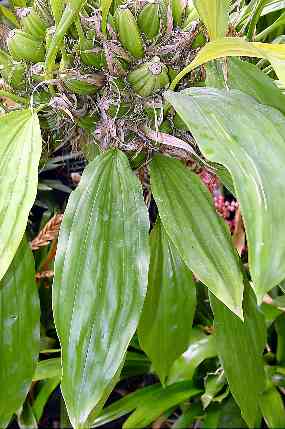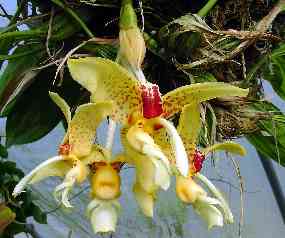Research and Conservation in Southern Sonora, Mexico
Stanhopea maculosa (toritos [generic])
Dense clusters of egg-sized, hard pseudobulbs bear evergreen, foot-long, thin but tough pleated leaves. The spectacular flowers hang down beneath the plant and are difficult to describe but easy to recognize once seen. However, they are rarely encountered because they last only a few days. The flowers emit a powerful, sweet fragrance.
 |
 Stanhopea maculosa in cultivation. Photos: Mark Dimmitt |
Description: Pseudobulbs ovoid, green, 60-70 mm long, 35-44 mm diameter. Leaves 44-53 cm long, the blades 27-53 cm long, 6-8.4 cm wide, elliptic-obovate with 5 major veins, the petioles 4.5-14.5 cm long. Flowers large, very fragrant, yellow and reddish-brown. Flowers last only three to five days.
Known in Sonora from one very large colony with hundreds of pseudobulbs on the lip of a huge boulder of a cliff face in the bottom of a moist canyon in the Sierra Saharibo west of Rancho Santa Bárbara, among oak forest at 1160 m. The tropical evergreen canyon bottom vegetation includes Magnolia pacifica, Platanus wrightii, Oreopanax peltatum, Cornus disciflora, Urera carascana, and Clethra lanata, and closely associated with Cuphea hookeriana, Senecio tepopana, and Tillandsia cretacea. Also occurs in Colima and Michoacán and is expected in Sinaloa.
Despite their short bloom duration, the numerous species of Stanhopea are widely cultivated because of their spectacular flowers. Unlike all other known species that grow in wet tropical forests, S. maculosa will not flower unless it experiences a spring dry period. Our species lives in an area with a nine-month dry season, yet it is obviously a mesic orchid. This fact probably explains why it is restricted to the very moist microhabitat of Arroyo Verde. The species has been in cultivation for many years, where it is the only species of about 30 in the genus that seems to require a spring dry rest in order to bloom.










